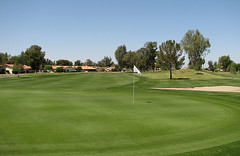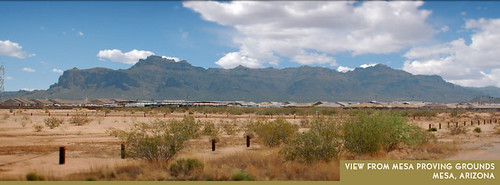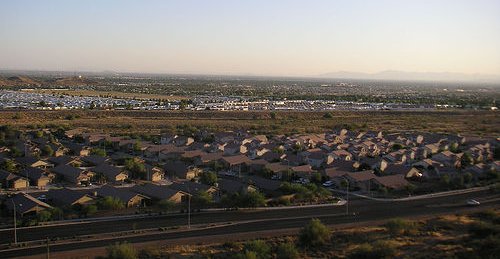A "megaresort" in the desert, dressed up as "downtown." Really.

Posted December 17, 2008 at 3:35PM
Does this look to you like an environmentally sustainable place to put a "destination resort, retail, and convention center core"?
Me neither. How about a golf course? Irrigation, anyone? Let's recreate a little bit of Scotland in the desert, shall we? Since the 407 lush green golf courses in otherwise desert-brown Arizona couldn't possibly be enough, let's have another.
Yet, some people in Mesa, Arizona seem to think this whole new second-home and convention mecca in the desert will be just the thing. From the municipality's press release earlier this fall:
"Mesa officials are excited about a deal that would bring a destination resort, retail and convention center core to Mesa Proving Grounds. The agreement between DMB Associates, Inc., a Scottsdale-based real estate company, and Gaylord Entertainment), a national hospitality and entertainment company based in Nashville, Tennessee, could mean the potential private investment of a billion dollars and millions of tourist dollars to Mesa, the Southeast Valley and the state. The announcement includes a partnership with Tom Fazio for an 18-hole golf course and the continued regional alliance with Westcor for future retail planning.
"The facility would add state-of-the-art meeting space for millions of new leisure and businesses visitors, and would make Mesa a national destination market providing an economic boost to the city, the Southeast Valley and Arizona, during all market cycles."
 By the way, Mesa, a place receiving less than ten inches of rain per year, already has over 70 golf courses.
By the way, Mesa, a place receiving less than ten inches of rain per year, already has over 70 golf courses.
Much of the city's press release is identical to one issued by the developer, DMB Associates, and its partner, Gaylord Entertainment. The construction of a major new airport is also in the works, even though Phoenix's international airport is only some 28 miles away. The empty Mesa site is the old General Motors "proving grounds" for testing their cars (which I suppose has been the secret of their success), but it is still mostly desert. It has since been purchased by DMB, which has plans. Big plans. My friend Merry put me onto this story via an article she saw in The Economist:
"Until it was temporarily halted by foreclosure and the credit crunch, Mesa was an extreme example of sunbelt growth. In 1940 it contained just 7,000 inhabitants, many of them Mormons. Then the explosion began. Driven by migration from the rest of America, Mesa's population roughly doubled in each of the next five decades. It now contains almost half a million people and has sprawled into a metropolis centered around the similarly fast-growing city of Phoenix. "It is the quintessential low-slung suburban city-what Yale University urbanist Dolores Hayden calls a 'boomburb.' Mile after mile of strip malls and tract houses, whose evocative names and fanciful arches cannot disguise the fact that they are large, stucco-covered boxes, dominate the landscape. Aside from the city hall and a shiny arts centre, most of Mesa's downtown district is only one storey high.
"When Mesa was growing explosively, the lack of a plausible downtown hardly mattered. But the city has been battered by foreclosure and may now be losing residents. Although it is hardly the only casualty in the region, Mesa is in especially poor shape. Too old to seem very new, but not nearly old enough to seem quaint, its appeal has dimmed. Mesa's solution is typical of the sunbelt: start building.
"Mesa's 'do-over', as Mr. Smith calls it, will take place south-east of the existing city. The land annexed this week is owned by a single developer, DMB, allowing for a unified vision. The opportunity to construct a new city centre is rare, and Mesa will become a test of modern urban design. It is looking both to the future and a long way into the past . . .
"Its downtown will depart from the north-south-east-west grid that most Western cities follow. The tilt is reckoned to be better for catching solar rays, but it is also meant to be a nod to history."
For starters, it is almost impossible to read the press releases and the story in The Economist and come away understanding that the site and planned development are the same in both. A "megaresort" built around a "hotel [that] will likely be the largest in the state of Arizona" is the same as a "downtown"? Being charitable, perhaps the resort is the first piece of development on the large site (3200 acres, or five square miles), while Mesa's boosters are hoping for much more. There is certainly optimistic, boosterish chat about development of the site, notwithstanding the current economic situation.
In The Economist's story, here's the part that, as someone who has enthusiastically (if not always without reservation) associated myself with the new urbanist movement, I find especially cringe-worthy:
"The new city will be a major showcase for 'new urbanist' theories, which have so far been applied most famously in much smaller towns like Celebration and Seaside, both in Florida . . ."
Ouch. Look, I have never actually seen the place or its detailed plans. But my distinct impression is that the plans that have been announced so far may be new, but neither they nor the megaresort they trumpet constitute "urbanism" in any common-sense use of the word. The place is certainly not a "city centre," or a center of anything, for that matter. Nor is it a "do-over" that will change any of the mess that makes Mesa such a poster child for sprawl:
This situation appears, rather, to be pretty much the opposite of what I recently described regarding the true new urbanist projects in Rockville, Maryland. The Rockville projects represent redevelopment that is replacing sprawl, built around public transit, not an expansion of their region's development footprint with an automobile-oriented "megaresort" in the desert. Another suburban makeover I wrote about recently, Reston Town Center, really is bringing a new downtown to the real center of an existing suburb.
What's happening in Mesa is simply spreading out onto new land. It is, at least so far, a resort-oriented development dressed up in planning jargon on a sprawl site in the desert. Giving it great PR, a little solar energy here and there, and even the best design in the world won't change any of that.


